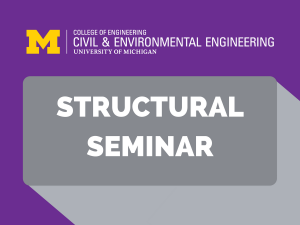Presented By: Civil and Environmental Engineering
Observation in Support of Analysis and Design of RC Structures
Santiago Pujol

The talk describes findings from numerical and experimental research as well as field work focused on the performance of RC structures. It includes a series of examples in which observations from the field and the laboratory were indispensable to support analyses leading to credible explanations of phenomena ranging from building collapses to basic resistance mechanisms in RC. Special attention is given to research addressing issues faced in the U.S. in the recent adoption of design provisions to allow the use of high strength steel (HSS) reinforcing bars (with yield stresses of up to 700 MPa) in buildings required to resist earthquake demands. The new provisions in the U.S. Building Code (ACI318-19) were motivated by industry and the need to reduce congestion and labor costs. The central questions in this process had to do with the plausible effects of the use of HSS reinforcement on both cyclic drift capacity and seismic drift demand of RC structures. In the case of drift capacity the main concerns included:
1) effects of different stress-strain curves on the distribution of curvature along an element,
2) reduced ultimate elongation and toughness of high-strength steels,
3) redefinition of limits to amount of reinforcement.
In the case of drift demand the described research explored the plausible effects of reductions in reinforcement ratio and, therefore, post-cracking stiffness. The problem of drift demand is examined in reference to earthquake records that have been obtained in the last 20 years and challenge common preconceptions about the properties of ground motion.
To close, a summary is presented to emphasize the importance of the use of data (observation) to support analysis and design in engineering, and the audience is offered open resources to access large collections of field and laboratory data related to the seismic performance of RC structures. Examples of new research directions (related to structural resilience and repair) are also offered to elicit questions and discussion.
Mr. Pujol is a professor in the Lyles School of Civil Engineering at Purdue University.
1) effects of different stress-strain curves on the distribution of curvature along an element,
2) reduced ultimate elongation and toughness of high-strength steels,
3) redefinition of limits to amount of reinforcement.
In the case of drift demand the described research explored the plausible effects of reductions in reinforcement ratio and, therefore, post-cracking stiffness. The problem of drift demand is examined in reference to earthquake records that have been obtained in the last 20 years and challenge common preconceptions about the properties of ground motion.
To close, a summary is presented to emphasize the importance of the use of data (observation) to support analysis and design in engineering, and the audience is offered open resources to access large collections of field and laboratory data related to the seismic performance of RC structures. Examples of new research directions (related to structural resilience and repair) are also offered to elicit questions and discussion.
Mr. Pujol is a professor in the Lyles School of Civil Engineering at Purdue University.